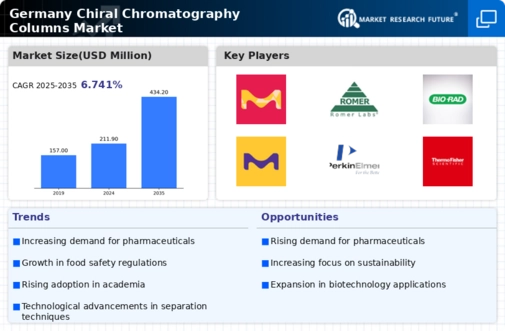Growth in Biotechnology Sector
Germany's biotechnology sector is witnessing rapid expansion, which is positively influencing the chiral chromatography-columns market. The country is recognized for its innovative biopharmaceuticals and bioprocessing technologies. In 2025, the biotechnology market in Germany is expected to grow at a CAGR of around 8%, leading to an increased requirement for chiral separation techniques. Chiral chromatography-columns play a crucial role in the purification of biologics and biosimilars, which are essential for therapeutic applications. As biopharmaceutical companies strive to develop new products, the demand for advanced chiral chromatography solutions is likely to rise, thereby propelling the growth of the chiral chromatography-columns market.
Rising Demand for Pharmaceuticals
The chiral chromatography-columns market is experiencing a notable surge in demand, primarily driven by the pharmaceutical sector. As the country is home to numerous pharmaceutical companies, the need for efficient separation techniques to produce enantiomerically pure compounds is paramount. In 2025, the pharmaceutical industry in Germany is projected to reach a market value of approximately €50 billion, with a significant portion allocated to research and development. This growth necessitates advanced chiral chromatography solutions to ensure compliance with stringent quality standards. Consequently, the chiral chromatography-columns market is likely to benefit from this increasing demand, as companies seek to enhance their production capabilities and meet regulatory requirements.
Advancements in Analytical Techniques
Technological innovations in analytical techniques are significantly impacting the chiral chromatography-columns market. The introduction of high-performance liquid chromatography (HPLC) and ultra-high-performance liquid chromatography (UHPLC) has enhanced the efficiency and resolution of chiral separations. In 2025, the market for HPLC systems is projected to grow by approximately 12%, indicating a robust demand for advanced chromatography solutions. These advancements enable researchers and manufacturers to achieve faster and more accurate results, thereby improving productivity. As the need for precise analytical methods continues to rise, the chiral chromatography-columns market is likely to experience substantial growth, driven by the adoption of these cutting-edge technologies.
Increased Focus on Environmental Sustainability
The chiral chromatography-columns market is also being influenced by a growing emphasis on environmental sustainability in Germany. As industries strive to reduce their ecological footprint, there is a shift towards greener analytical methods. This trend is particularly relevant in the context of chiral chromatography, where the development of environmentally friendly solvents and processes is gaining traction. In 2025, it is anticipated that around 30% of companies in the chemical and pharmaceutical sectors will adopt sustainable practices, which may include the use of chiral chromatography-columns that minimize waste and energy consumption. This shift could create new opportunities for manufacturers of chiral chromatography-columns, as they adapt to meet the evolving demands of environmentally conscious consumers.
Increasing Investment in Research and Development
Investment in research and development (R&D) is a critical driver for the chiral chromatography-columns market. With a strong emphasis on innovation, both public and private sectors are allocating substantial funds to R&D initiatives. In 2025, it is estimated that R&D spending in the chemical and pharmaceutical industries will exceed €10 billion, fostering advancements in separation technologies. This influx of investment is likely to stimulate the development of novel chiral chromatography-columns that cater to specific applications. As companies seek to enhance their competitive edge through innovative solutions, the chiral chromatography-columns market is expected to thrive, benefiting from the increased focus on R&D.

















Leave a Comment